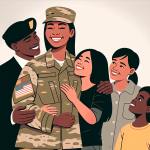Definition
A covering force in military operations refers to a specific type of force that is positioned in front of the main body of troops. Its main responsibility is to delay, disrupt, or prevent enemy attacks, thereby granting protection to the main force. They also help in providing a secure environment for the main force to prepare and execute their operations.
Key Takeaways
- A covering force is a significant military formation or unit that is deployed to protect a larger force from enemy actions. This includes guarding against surprise attacks, ambushes, or other direct threats to the main force.
- The covering force often operates at a distance from the main force. It conducts reconnaissance, counter-reconnaissance, and security tasks to completely shield the main body of the force. This detachment allows the main force to focus on accomplishing their primary mission without immediate direct engagement with the enemy.
- The size, composition, and role of a covering force can vary significantly depending on the nature of the military operation. It can comprise infantry, armored, mechanized, or special forces units, and may include air and naval elements. As a multi-purpose and flexible force, it adapts to the strategic requirements of the main body it protects.
Importance
The term “Covering Force” in military operations is significant because it plays a vital role in safeguarding the main body of troops from unexpected enemy attacks during both offensive and defensive operations.
Covering forces are essentially the first line of defense, tasked with delaying, disrupting, or preventing enemy actions, thereby buying critical time for the main forces to organize, prepare and execute their operations.
They provide early warning to the main forces, conduct reconnaissance, and even deceive the enemy about true intentions of the main force.
Without an effective covering force, the main body of troops can potentially be vulnerable to surprise attacks or aggressive enemy maneuvers, which can greatly affect the outcome of any military operation.
Explanation
Covering force is essentially a military component that is primarily utilized to guard and protect the main force. The purpose of the covering force in military operations is to prevent the premature engagement of the main body, delay enemy action, disrupt enemy operations, provide early warnings, deceive the enemy, as well as to erode and weaken the potency of the enemy attack.
Therefore, the principal task of the covering force is to safeguard the main body of troops from an unexpected adversary attack, affording the main force the much-needed time and space to adequately prepare for battle, maneuver, or accomplish mission objectives. Additionally, the covering force plays a significant role in reconnaissance and surveillance operations.
They are used to keep an ‘eye’ on the enemy operations, making it possible to evade enemy surprise attacks and provide the main force with critical tactical information about the enemy – such as the enemy’s disposition, strength, intentions, and capabilities. While engaging with the enemy, the covering force also works to upset the enemy’s tactical coherence and stability by exploiting their vulnerabilities, hence reducing the enemy’s combat effectiveness when they finally confront the main force.
By doing so, the covering force substantially contributes to ensuring the relative tactical superiority and operational success of the main force.
Examples of Covering force
Operation Granby: One of the major real-world examples of a “Covering Force” was seen in 1991 during Operation Granby, also known as the Gulf War. The UK’s 1st Armoured Division was tasked with serving as the covering force for the US VII Corps. As the VII Corps advanced deep into Iraq to cut off and destroy the Iraqi Army, the 1st Armoured Division defended their flanks against any potential enemy counterattacks, enabling the US forces to complete their objectives.
The Battle of Gettysburg: During the historic Civil War, the Union Army’s Cavalry Division, under the command of John Buford, acted as a covering force. Buford’s cavalry set up defensive positions to buy time for the rest of the Union army to arrive in Gettysburg to face off against the Confederate forces. Their role was crucial in slowing down the Confederates and allowing Union forces to establish strong positions.
Operation Neptune: The Normandy Invasion during World War II exemplifies a multi-layered use of covering forces. The paratroopers from the 82nd and 101st Airborne Divisions, as well as British 6th Airborne, were dropped behind enemy lines to secure key bridges and cause disruption, serving as a covering force for the beach landings at Normandy. While the paratroopers engaged German defenses, the main invasion force prepared for the amphibious assault on Normandy’s beaches. Their engagement with the German defense shield allowed the main force to land and establish a strong foothold.
FAQs about Covering Force
What is a Covering Force?
A Covering Force is a military term that refers to a force that operates apart from the main force to draw the enemy’s attention, disrupt their operations, or prevent surprise attacks.
What is the main task of a Covering Force?
The main task of a Covering Force is to protect the main force from enemy attacks during military operations. It does this by providing early warning of enemy activities and by denying the enemy information about the main force.
What elements make up a Covering Force?
A Covering Force is usually made up of various elements such as advance guard units, reconnaissance units, and reserve units. The specific composition of a Covering Force can vary depending on the nature of the military operation.
How is a Covering Force used in defensive operations?
In defensive operations, a Covering Force is used to delay and disrupt the enemy’s advance towards the main defensive line. It achieves this by launching surprise attacks, creating obstacles, and conducting spoiling attacks.
How is a Covering Force used in offensive operations?
In offensive operations, a Covering Force is employed to secure the flanks of the main force, prevent enemy counterattacks, and to help prepare the ground for the main assault by suppressing enemy positions.
Related Military Operation Terms
- Military Retirement Benefits
- Veterans Health Care
- VA Housing Assistances
- Vocational Rehabilitation and Employment
- Survivor’s Benefits
Sources for More Information
- Encyclopedia Britannica: This esteemed encyclopedia can give you a general understanding of the term ‘Covering Force’ in a military context.
- Military Factory: This website provides specific information about the military, which often includes the strategic use of a Covering Force.
- The Joint Chiefs of Staff: As will be recognized from the official website of the U.S. Department of Defense, this source provides credible military strategic and operational information.
- U.S. Army Center of Military History: This official military history website may include specific examples of the use of a ‘Covering Force’ in historical battles and campaigns.
 Benefits.com Advisors
Benefits.com Advisors
With expertise spanning local, state, and federal benefit programs, our team is dedicated to guiding individuals towards the perfect program tailored to their unique circumstances.
Rise to the top with Peak Benefits!
Join our Peak Benefits Newsletter for the latest news, resources, and offers on all things government benefits.




















